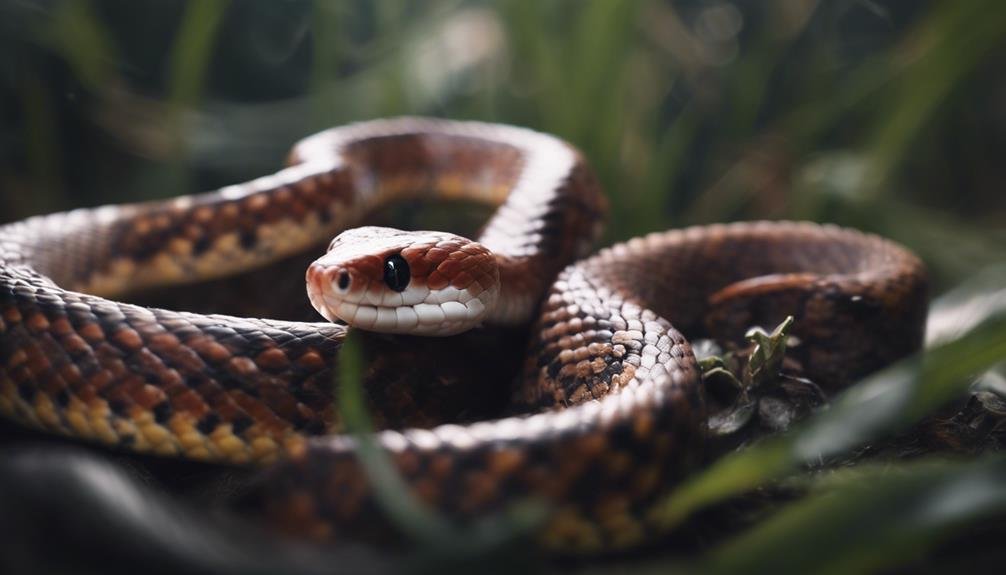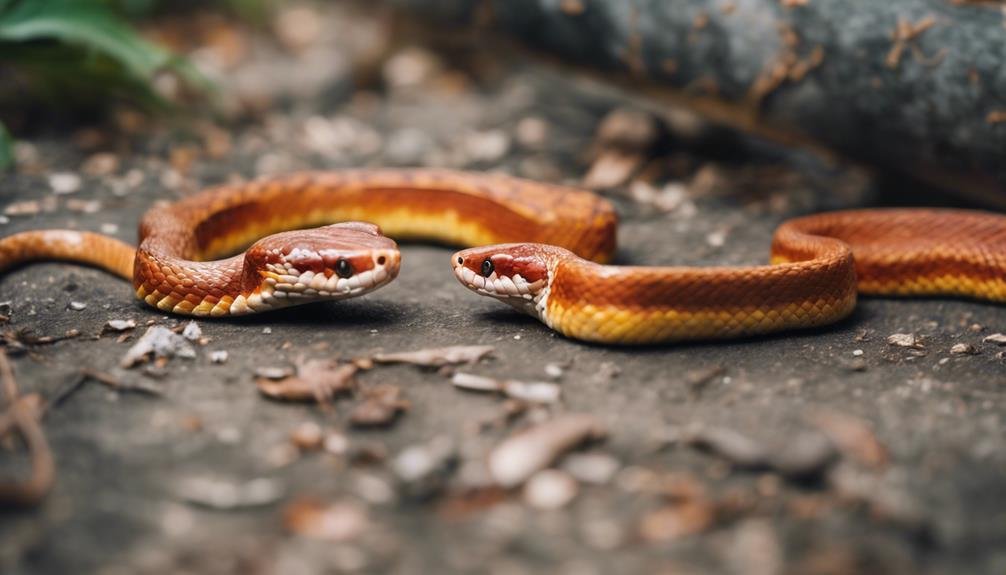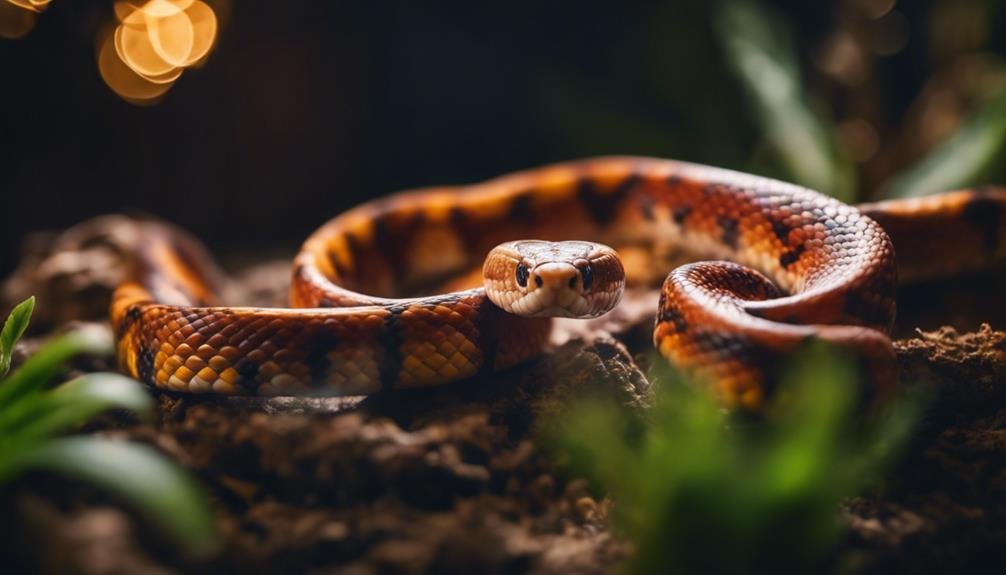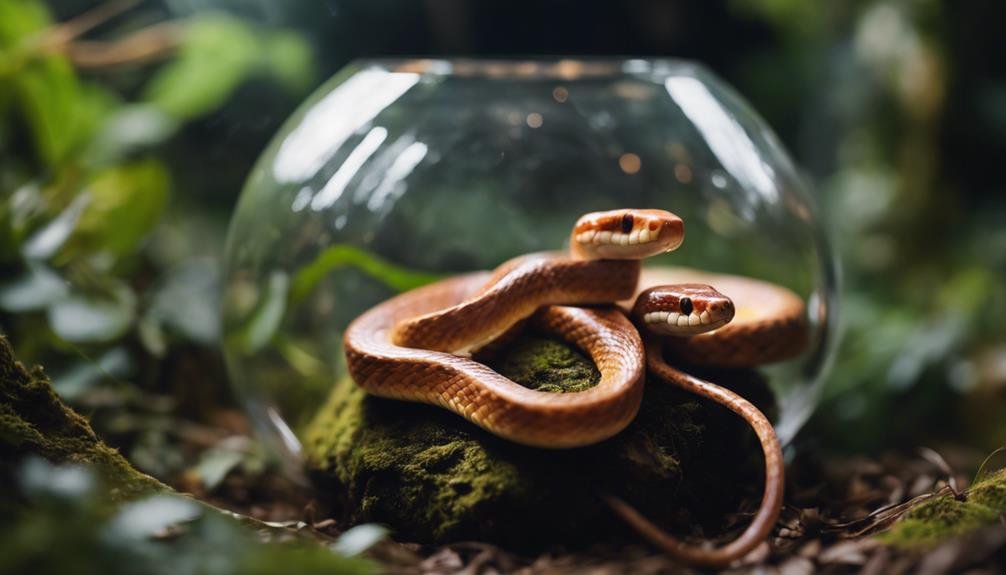You might wonder if your corn snakes can share a living space, considering their solitary nature. While they're known for their docile demeanor, placing them together can trigger stress, fear, and even aggression. The potential for dominance battles, stress-related health issues, and in some cases, cannibalism, cannot be overlooked. As you explore the intricacies of their behavior and environmental needs, remember, understanding their solitary preference is vital for their well-being. The question remains: how can you guarantee a harmonious habitat for these reptiles without compromising their health and safety? The answer might surprise you.
Key Takeaways
- Corn snakes are naturally solitary and thrive best when housed individually to prevent stress and aggression.
- Co-habitation can lead to stress-induced health problems, including a weakened immune system and behavioral changes.
- Aggressive behaviors such as chasing and biting among corn snakes indicate stress, fear, and the need for immediate separation.
- Risk of cannibalism and food aggression increases in shared enclosures, highlighting the importance of separate habitats.
- Separate enclosures during breeding season prevent conflicts and ensure the well-being and safety of corn snakes.
Natural Solitary Behavior
In the wild, corn snakes naturally prefer to live alone, highlighting their intrinsic solitary behavior and reducing competition for resources. This preference isn't just a matter of importance; it's deeply ingrained in their survival strategy. They've evolved to thrive in solitude, hunting and exploring without the need for companionship. This solitary behavior isn't a sign of loneliness, rather it's a validation of their independence and self-sufficiency.
You might wonder how this affects their care in captivity. Well, mimicking their natural lifestyle by providing individual housing isn't just recommended; it's vital for their well-being. When corn snakes are housed alone, it allows them to establish their own territory, just as they'd in the wild. This eliminates the stress and potential for conflict that could arise from forced interactions with other snakes. It's not about isolation—it's about creating an environment that respects their natural inclinations and promotes their health.
Aggression and Dominance Issues
Why should you be concerned about aggression and dominance issues when considering housing corn snakes together? Recognizing the signs of aggression and understanding their implications are important. Aggressive behaviors, such as chasing and pinning down with the jaw, often signal mating attempts rather than simple cohabitation disputes. This is significant because it can lead to unwanted egg-laying if not quickly addressed.
To help you identify and address these behaviors, here's a quick guide:
| Behavior | Indication | Action Required |
|---|---|---|
| Chasing and pinning | Mating attempt | Quick separation |
| Open mouth biting | Aggression/mating | Observe closely |
| Pushing down | Dominance assertion | Separate snakes |
| Visual cues recognition | Prevent stress | Monitor interactions |
Understanding these cues is important. For instance, open mouth biting or pushing down should alert you to potential mating intentions or dominance issues. Immediate separation of the snakes involved is crucial to prevent unwanted mating and the stress associated with cohabitation. By addressing aggression and mating behaviors promptly, you're not only preventing potential health issues but also ensuring a peaceful environment for your corn snakes.
Stress-Induced Health Problems


Housing corn snakes together can trigger stress-induced health issues, including decreased appetite and weight loss, greatly impacting their well-being. When you decide to keep corn snakes in the same enclosure, it's essential to recognize that cohabiting can lead to more than just occasional disputes; it can cause profound stress problems that compromise their health.
If you're considering cohabiting corn snakes, here's what you need to know about the stress-induced health problems they may face:
- Weakened Immune System: Prolonged stress from living together can make corn snakes more vulnerable to infections.
- Skin and Respiratory Issues: Stress can manifest physically, leading to skin problems and respiratory issues, which are signs your snakes aren't thriving together.
- Behavioral Changes: Signs such as hiding more than usual, excessive basking, or showing erratic movements can indicate your corn snakes are experiencing stress.
- Increased Susceptibility to Infections: Stress compromises their immune system, making them more prone to infections.
Understanding these signs and taking action by separating stressed corn snakes can alleviate their anxiety, improve their health, and prevent stress-related issues before they escalate into more severe problems or injuries.
The Risk of Cannibalism
You may find it shocking, but corn snakes can turn to cannibalism under certain conditions, such as when there's a significant size difference or if they're particularly hungry. Understanding why this happens and how to prevent aggression among them is essential for their well-being.
Identifying the warning signs early on can help you intervene before any harm occurs, ensuring all your snakes stay safe and healthy.
Cannibalism Causes
Corn snakes can exhibit cannibalistic behavior when resources are scarce, targeting smaller or weaker mates within their enclosure. This alarming trend arises not from a natural predilection towards cannibalism but from a survival instinct when conditions are less than ideal.
Understanding the causes is important:
- Competition for resources: Limited access to food heightens stress and aggression.
- Size disparity: Larger or more dominant snakes may view smaller ones as prey.
- Stress and overcrowding: High stress levels and lack of space can trigger cannibalistic tendencies.
- Insufficient feeding: Not getting enough food can drive snakes to view each other as potential meals.
To keep your scaly friends safe and healthy, it's essential to address these issues proactively, ensuring each snake has the space and resources it needs.
Preventing Snakes' Aggression
To effectively prevent aggression and the risk of cannibalism among corn snakes, it's important to understand and implement proper housing strategies. Cohabiting can lead to aggression, especially if your snakes compete for territory or resources. This is particularly true when mixing male and female corns, as their interactions might escalate into fights.
Aggression can spiral into cannibalism if one snake perceives the other as prey, often due to size differences or if one appears weakened. Hence, providing separate enclosures for each snake is vital. It not only prevents territorial disputes but also eliminates competition for food and basking spots. Keeping your corn snakes apart ensures their well-being, greatly reducing the risks of aggression and cannibalism among them.
Identifying Warning Signs
Understanding the warning signs of cannibalism is essential when housing corn snakes together, as it can help prevent tragic outcomes. The risk of cannibalism increases significantly in environments where snakes of different sizes or ages are kept close to each other. This proximity can lead to one snake mistaking another for prey, resulting in bites, injuries, or even a snake consuming its enclosure mate.
To mitigate these risks, consider the following:
- Monitor for injuries or missing limbs, indicative of aggressive encounters.
- Be vigilant for any snake attempting to consume another.
- Guarantee proper housing in separate enclosures to eliminate cannibalism risk.
- Regularly assess each snake's health and behavior for any signs of stress or aggression.
Proper housing isn't just about comfort; it's essential for their safety and well-being.
Feeding Challenges in Co-habitation
When you're keeping corn snakes together, feeding them becomes a bit more complex. You've got to watch out for food aggression and make sure each snake gets its fair share, to avoid any health issues or fights.
Consulting a reptile specialist can help you set up a feeding schedule that meets all their needs without causing stress or competition.
Risk of Food Aggression
Corn snakes living together may face food aggression, vying for the same prey and potentially causing harm to one another. When cohabiting, these snakes can display aggressive behaviors during feedings, like latching onto each other, which can lead to injuries and heightened stress levels.
To mitigate the risk of food aggression:
- Create separate feeding areas to make sure each snake has its own space.
- Monitor feeding sessions closely to prevent conflicts.
- Understand and cater to individual feeding habits.
- Adjust feeding schedules to minimize stress and fear among cohabiting snakes.
Unequal Food Distribution
In co-habited environments, ensuring each corn snake receives its important share of food is vital to prevent competition and maintain peace. Unequal food distribution can lead to the snakes, especially females, competing for the best resources. This competition can cause stress and potential fighting, disturbing the harmony within their shared space.
Providing a fair share of food to each snake is essential to avoid aggression and ensure they both receive proper nutrition. Overfeeding one while underfeeding the other can result in health issues, escalating stress levels. By monitoring their feeding behavior and adjusting portions as necessary, you'll help maintain a harmonious living environment.
Establishing a feeding schedule and ensuring equal access to food resources can prevent conflicts, promoting the well-being of your cohabiting corn snakes.
Breeding Season Conflicts


During breeding season, keeping corn snakes together can lead to increased aggression and territorial disputes. This period greatly alters their behavior, making even previously peaceful snakes turn against each other. The drive to mate triggers an instinctual response leading to dominance struggles and mating attempts, which unfortunately can escalate into fights. These conflicts aren't only stressful but can result in serious injuries or even death for your corn snakes.
To safeguard your pets during this volatile time, it's essential to recognize the importance of separate cages. Here's why:
- Prevents Stress: Keeping snakes apart reduces the stress associated with constant competition and aggression, promoting a healthier environment.
- Avoids Injuries: Separation eliminates the risk of physical harm caused by fights, ensuring both snakes remain safe.
- Ensures Health: Stress and injuries can lead to secondary health issues. Separate cages help maintain a healthy state during this sensitive period.
- Promotes Successful Breeding: By controlling interactions, you can prevent premature or unwanted breeding attempts, leading to a more successful and controlled breeding process.
Breeding season conflicts necessitate the use of separate cages to protect your corn snakes from the potential harm that comes with their natural instincts during this time.
Space and Territory Needs
Understanding the importance of individual space and territory is vital when caring for corn snakes to guarantee their well-being and prevent stress-related behaviors. Corn snakes require their own space and territory to thrive, avoiding the stress and aggression that come from overcrowding. When these snakes are forced to share a confined area without clear territorial boundaries, it can lead to fear, fighting, and significant stress, negatively impacting their health.
To make sure each snake feels comfortable and secure, providing separate cages is a straightforward solution. This arrangement respects their need for individual space and prevents the development of dominance issues that can arise in multi-snake environments. By acknowledging and accommodating the space and territory needs of corn snakes, you're taking an essential step in promoting a healthy, stress-free environment for them.
Can Stress and Fear from Living Together Cause Corn Snakes to Fight?
Yes, stress and fear from living together can cause corn snakes to fight. Ball python shedding skin reasons can lead to territorial disputes and aggression. It’s important to provide separate hiding spots, proper feeding, and a stress-free environment to prevent fighting among corn snakes.
Signs of Stress in Corn Snakes


You'll notice signs of stress in corn snakes, such as hiding and refusing food, which demand immediate attention to prevent health issues. When your corn snake starts showing unusual behaviors, it's important to take immediate action to identify and rectify the source of their stress. Beyond the obvious signs, there are more subtle indicators that your snake isn't at ease.
- Hiding excessively: While it's normal for corn snakes to seek shelter, constant hiding is a red flag indicating stress.
- Increased aggression: A usually docile corn snake showing sudden aggression towards you or other tank mates is a clear sign of distress.
- Physical health decline: Symptoms like weight loss, lethargy, and abnormal shedding patterns are direct indicators of stress affecting your snake's physical well-being.
- Behavioral changes: Frequent attempts to escape, excessive pacing, and hissing are behavioral changes that signal your corn snake is uncomfortable with its current environment.
Understanding these signs is important for the health and happiness of your corn snake. Regularly monitoring for stress indicators and adjusting husbandry practices accordingly can help alleviate stress, ensuring your corn snake leads a healthy, content life.
Proper Housing Recommendations
To ensure the health and happiness of your corn snakes, it's crucial to provide each one with its own separate enclosure. Separate cages are necessary for preventing stress, fear, and fighting among these reptiles. When you house snakes together, you're inviting territorial disputes and potential injuries, which nobody wants for their pets.
By opting for individual enclosures, you're ensuring that each snake has its own space and resources. This is essential to avoid dominance issues and aggressive behaviors that often arise in cohabitation situations. Remember, corn snakes are solitary creatures by nature, and forcing them to share a space goes against their instincts, leading to unnecessary stress.
Proper housing setups, which include separate cages for each snake, not only help reduce stress but also promote the overall well-being of your pets. This approach to care respects their natural behaviors and needs, leading to healthier, happier snakes. So, when setting up your corn snake habitat, always opt for individual enclosures. This will create a peaceful environment for your pets, free from the risks associated with cohabitation.
Conclusion
To sum up, you've got to house corn snakes separately to keep them healthy and stress-free. Their solitary nature means they don't play well together, risking fights, stress, and even cannibalism. Watching for stress signs and giving each snake its own space are key.
Remember, cohabiting can lead to more problems than it's worth, especially during feeding and breeding times. Stick to individual housing to make sure your corn snakes live peacefully and thrive.


